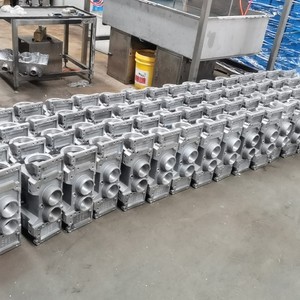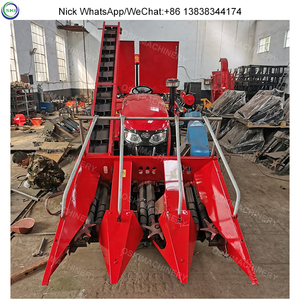(968 products available)






































































































































































































Corn headers for combines come in a variety of configurations. Some are compatible with the generic vertical pipe that most combines use to intake the corn. Some corn headers for sale are set up to interface with a three-point hitch.
Row Independent
A harvested rows independent corn header can cope with unevenly spaced or varied row spacing. Corn headers of this type can harvest corn in various row spacing. Their versatility makes them suitable for fields where row spacing may not be consistent, such as in replant or irrigated fields. They can also be used in rotational fields where corn is alternated with other crops. Additionally, row-independent corn headers are effective in fields where stand density is low due tovariable growing conditions.
Row Fixed Corn Headers
For those with a set spacing that works well for their fields, a row-fixed corn header may suffice. This type of corn header is designed to harvest corn in a specific row spacing configuration. Typically, these headers include gatherers and snouts that are precisely positioned to efficiently gather and harvest corn in a designated row spacing. Using row-fixed corn headers can be more cost-effective and efficient when their row spacing aligns with the farmer's field configuration.
Flex Corn Headers
Flex corn headers have a movable cutting platform that conforms to the ground. Farmers can benefit from this aspect when harvesting corn planted in uneven or rolling terrain. The adaptability of flex corn headers also enhances the overall efficiency of the harvest by reducing the occurrence of header trash resulting from the gathering of organic material rather than just plants.
Rigid Corn Headers
Rigid corn headers feature a fixed cutting platform that does not adapt to the terrain. These headers are suitable for use in well-drained, level fields with little trash. Rigid headers can be less expensive than flexible ones, but they are also less versatile in uneven terrain.
Working Width
The overall width of the corn header when mounted on the harvester. Typical corn header widths range from 6 to 20 feet, depending on the number of rows.
Row Configuration
This includes the total number of rows and the row spacing. For instance, a corn header with a 12-row configuration may be designed for a corn field where the rows are 30 inches apart.
Cutting Mechanism
This can be a direct cut, shear bar cut, or a specific type of patented cutting technology. Some headers also have predetermined cutting heights for different types of soil and crop conditions.
Snap Beans
Corn headers usually have snap beans to allow corn to pass through and get snapped. The material and length of the snapbeans affect their efficiency in snapping the crops. A typical snapbean is made from cast iron and is one meter long.
Incline and Conveyors
An integrated conveyor system helps in transporting the harvested crop to the combine for processing. The type of conveyor, such as belt or auger, and its capacity is crucial.
Mounting Compatibility
Compatibility between the corn header and various combine harvesters is crucial. Specific mounting brackets and interfaces are required to ensure a secure attachment.
Weight
Because of its impact on the balance and lifting capacity of the combine harvester, the weight of the corn header is important. A typical corn header weighs between 2,000 and 10,000 pounds. ".
Harvesting corn fields:
The main and most important use of a corn header is for harvesting corn fields. Whether it's a small farm or a large-scale commercial farm, corn headers are crucial for efficiently and effectively reaping corn crops. Different types of corn headers cater to various harvesting needs and corn cultivation scales. With their special designs for grasping and cutting corn ears, corn headers speed up the harvesting procedure.
Managing diverse farming systems:
Apart from just corn, headers for corn can also be used in farming setups where different crops are planted together. For instance, in places where both corn and beans are grown, or in fields with complicated crop arrangements, corn headers can still work well. This adaptability allows for easy handling of varied farming situations, making them useful even beyond just corn harvesting. This versatility proves that headers designed for corn can meet the demands of various agricultural settings.
Farms of all sizes:
Whether it's a large farm or a small one, corn headers are essential tools. On bigger farms with extensive corn fields, efficient harvesting is crucial, and corn headers can cover large areas quickly. Even on smaller family-run farms, time-saving during the harvest is important. Corn headers are key pieces of equipment for both smallholder farmers and large-scale agricultural operations.
When selecting a corn header for sale, buyers should consider various factors regarding the corn header's compatibility, capacity, efficiency, technology, maintenance requirements, safety features, and dealer support.
Q1: What is the difference between a row corn header and a universal corn header?
A1: A row corn header is designed to fit over a single row of corn plants, making it ideal for harvesting a smaller area of corn. While the universal corn header can be used to harvest different types of crops, it may not be as efficient as headers specifically designed for particular crops.
Q2: What is the process of using a corn header for harvesting?
A2: Once the corn header is attached to the harvesting machine, the machine is driven into the corn field. The corn header is lowered into the field at an appropriate height. The corn header is then moved forward at a speed that allows efficient harvesting. After harvesting the entire corn field, the corn header is raised and taken back to the farm.
Q3: How does customizing a corn header affect performance?
A3: Customization can enhance adaptability to specific field conditions, improve harvesting efficiency, and reduce crop damage.
Q4: What are the trends in corn header technology?
A4: Key trends include increasing adoption of air flow headers, GPS-guided automated headers, and improvements in material durability and cutter bar technology.